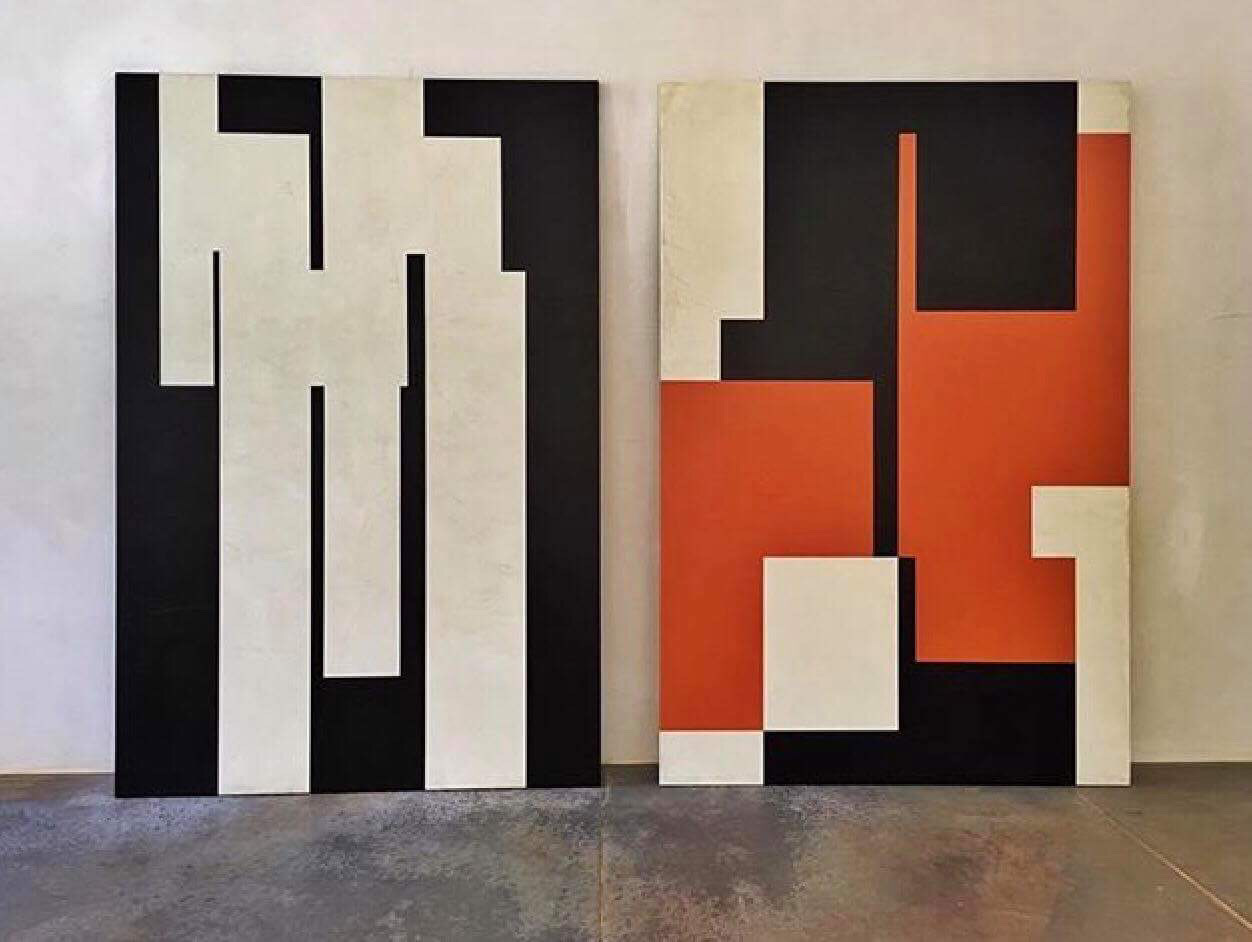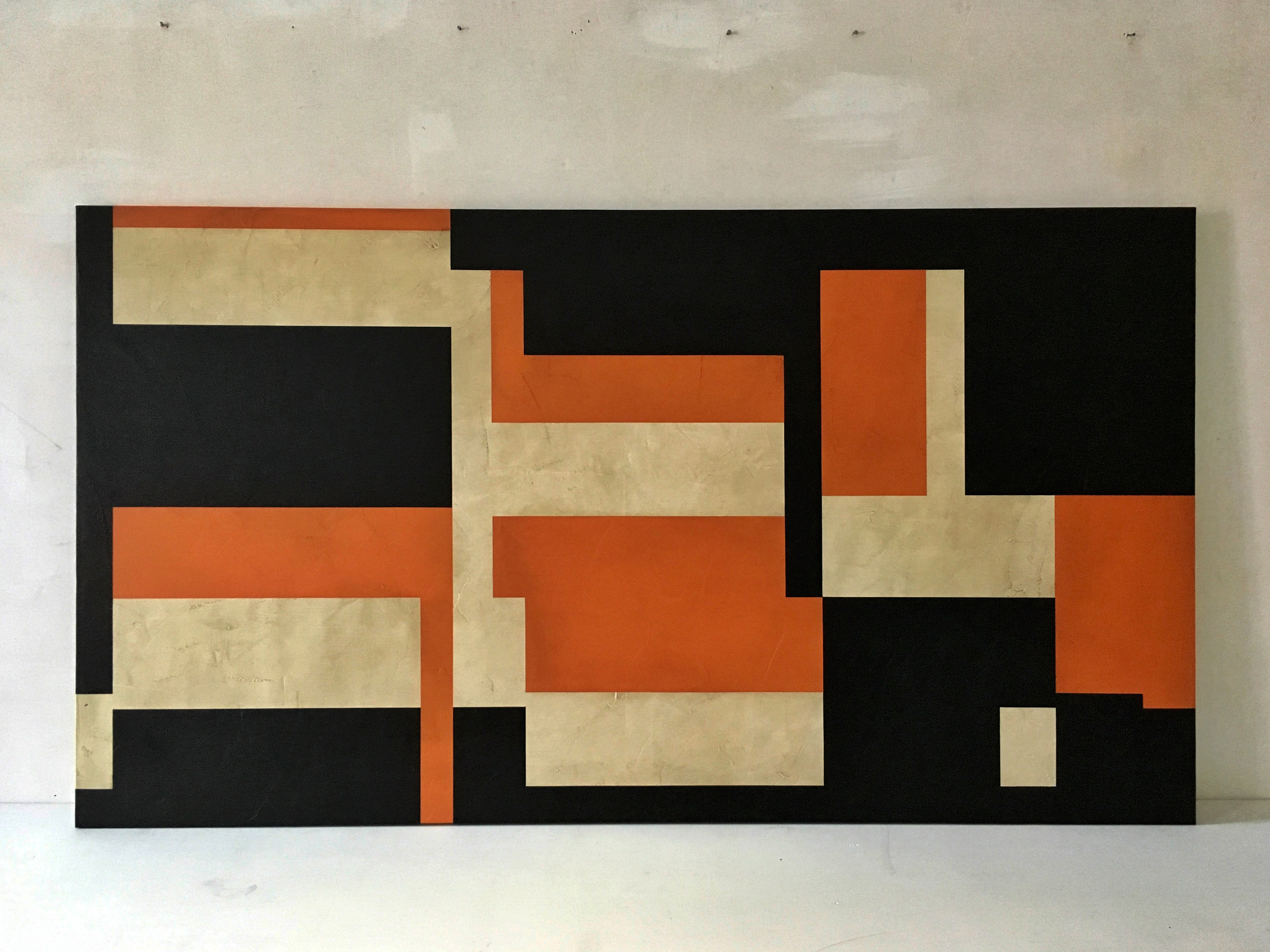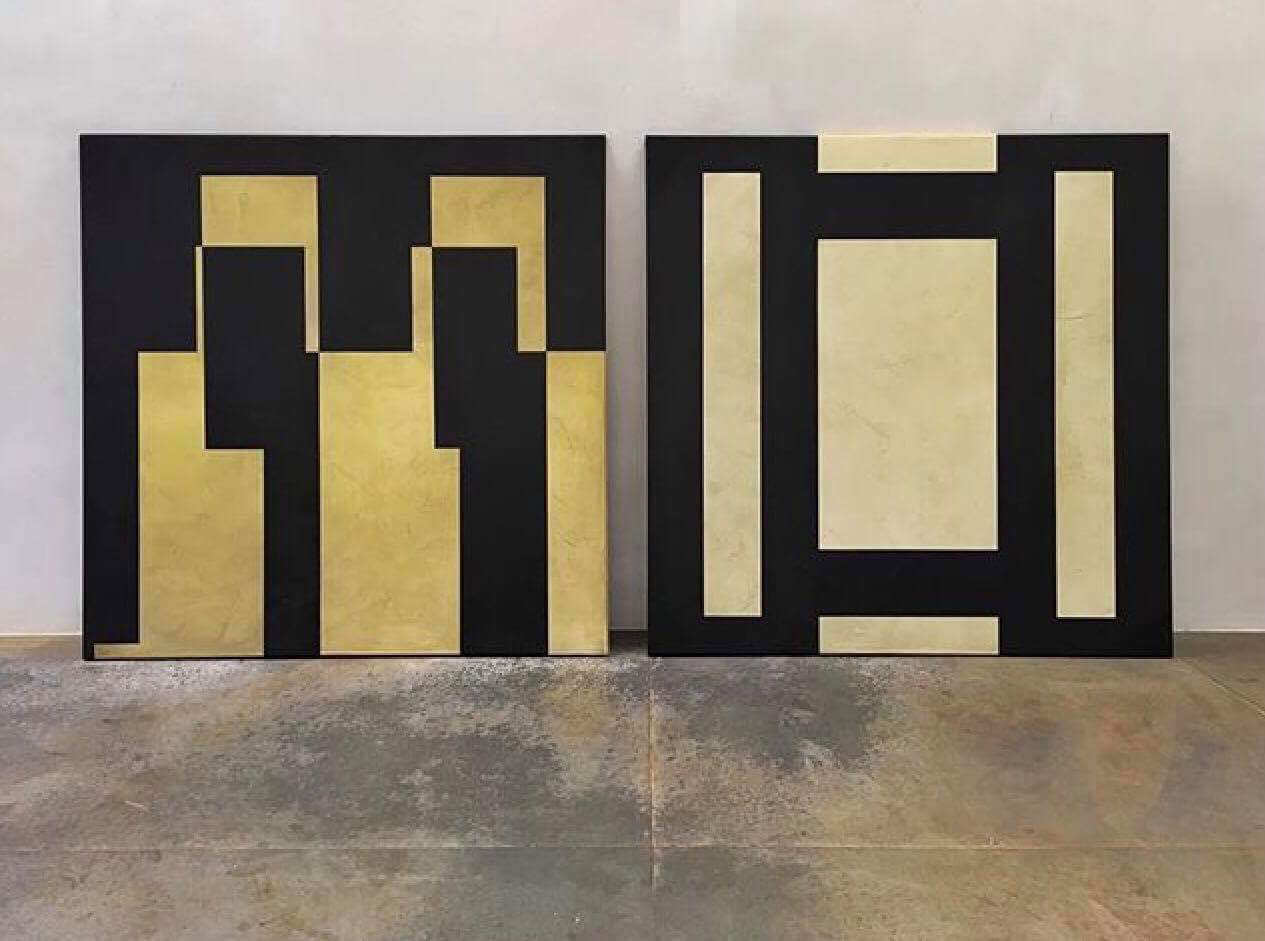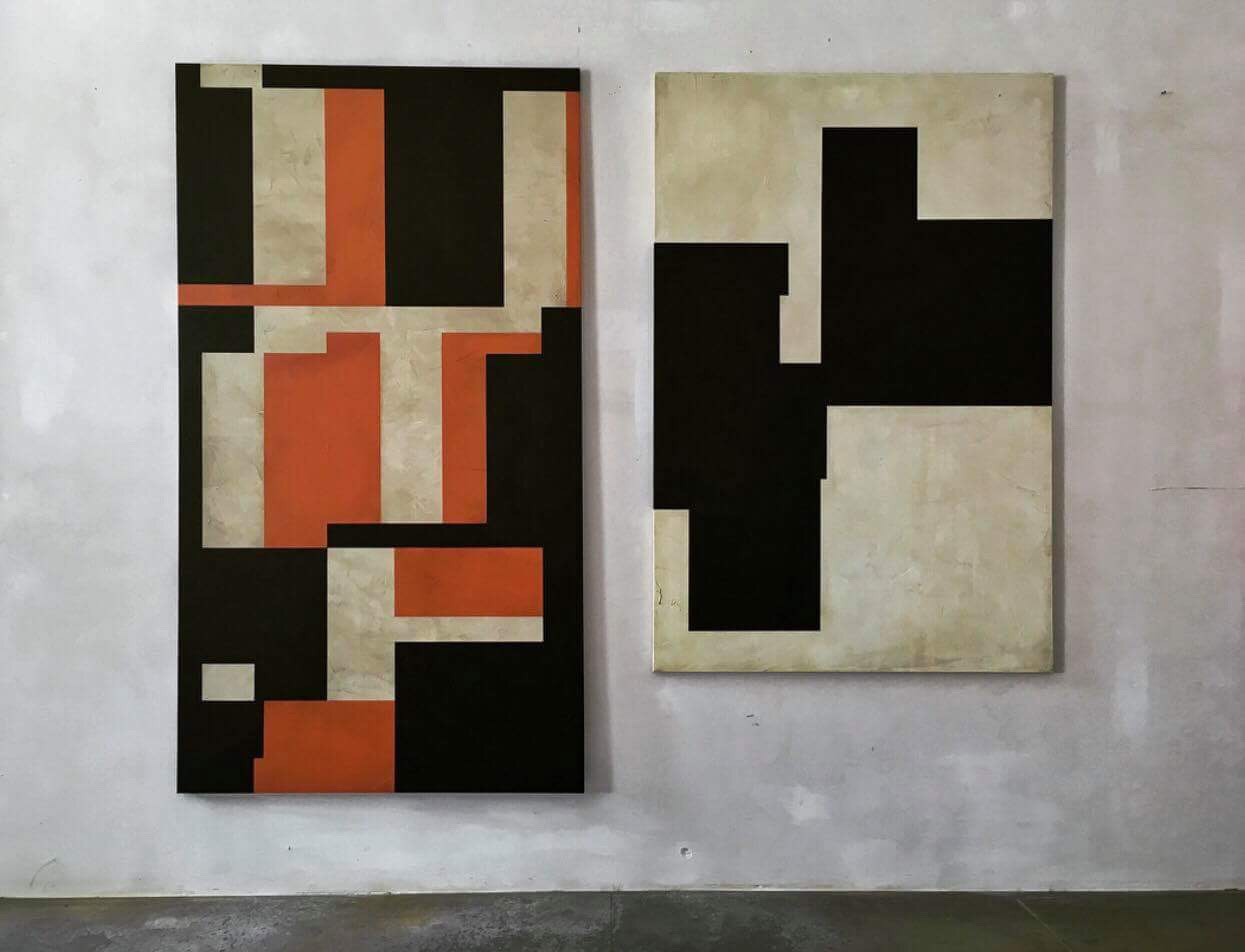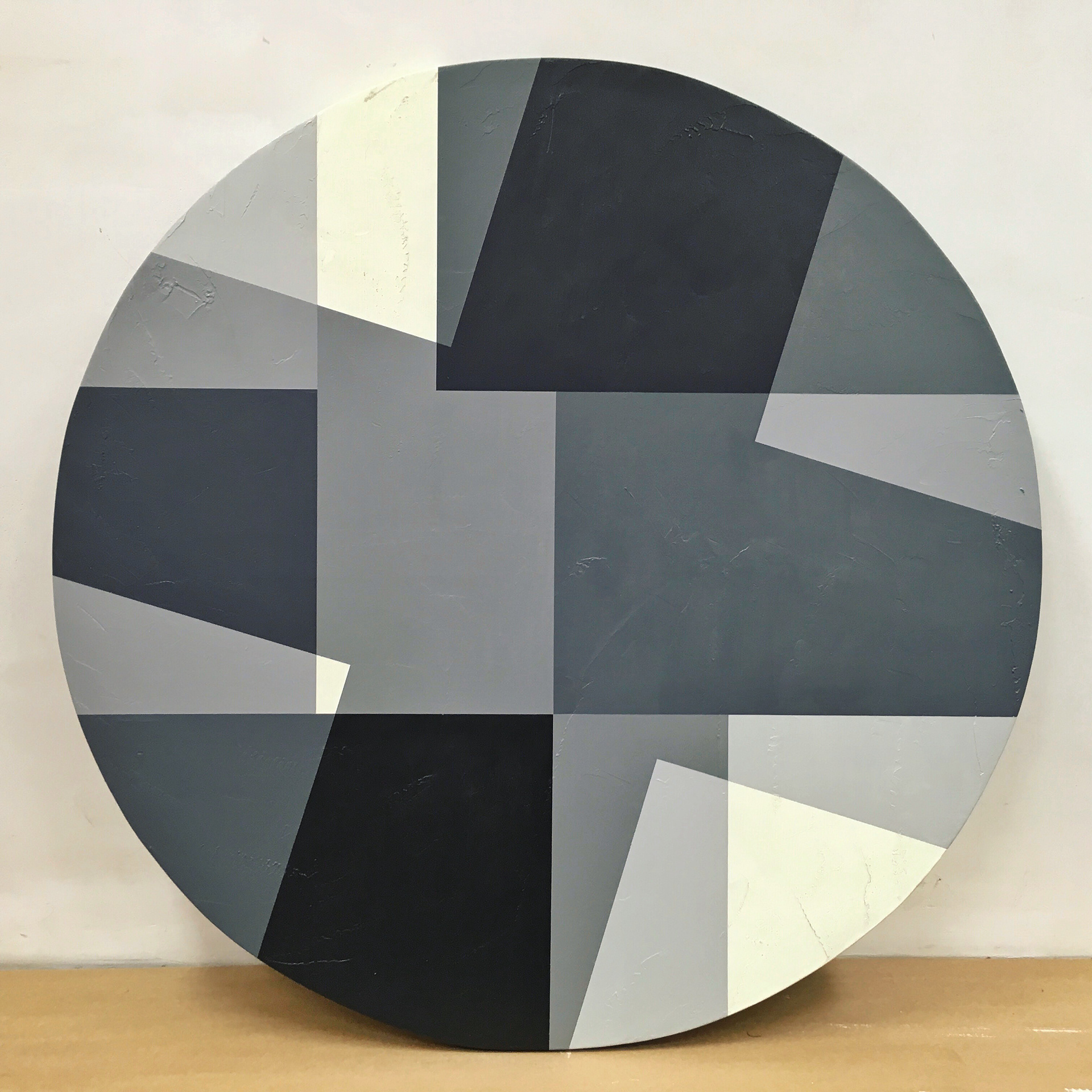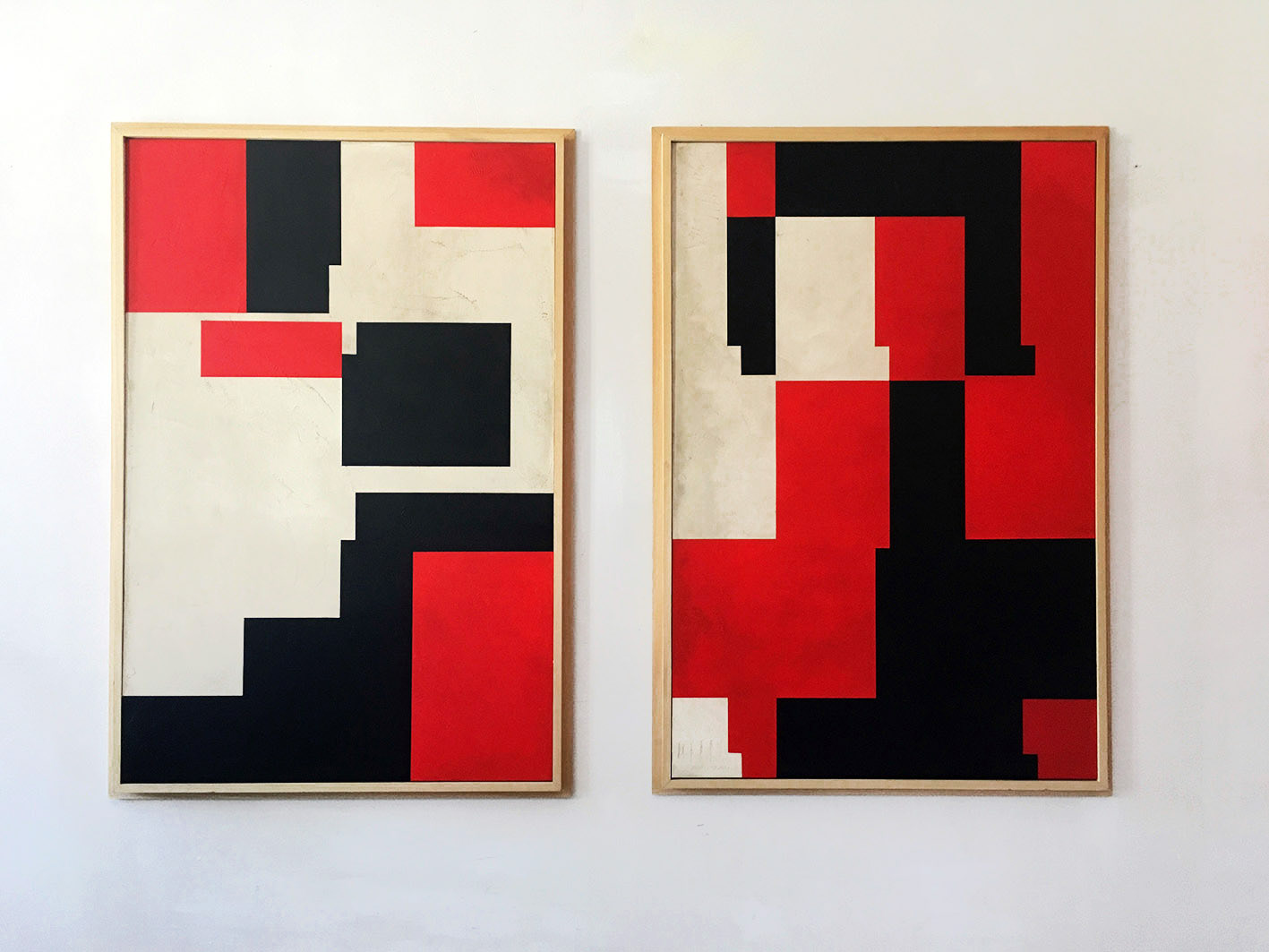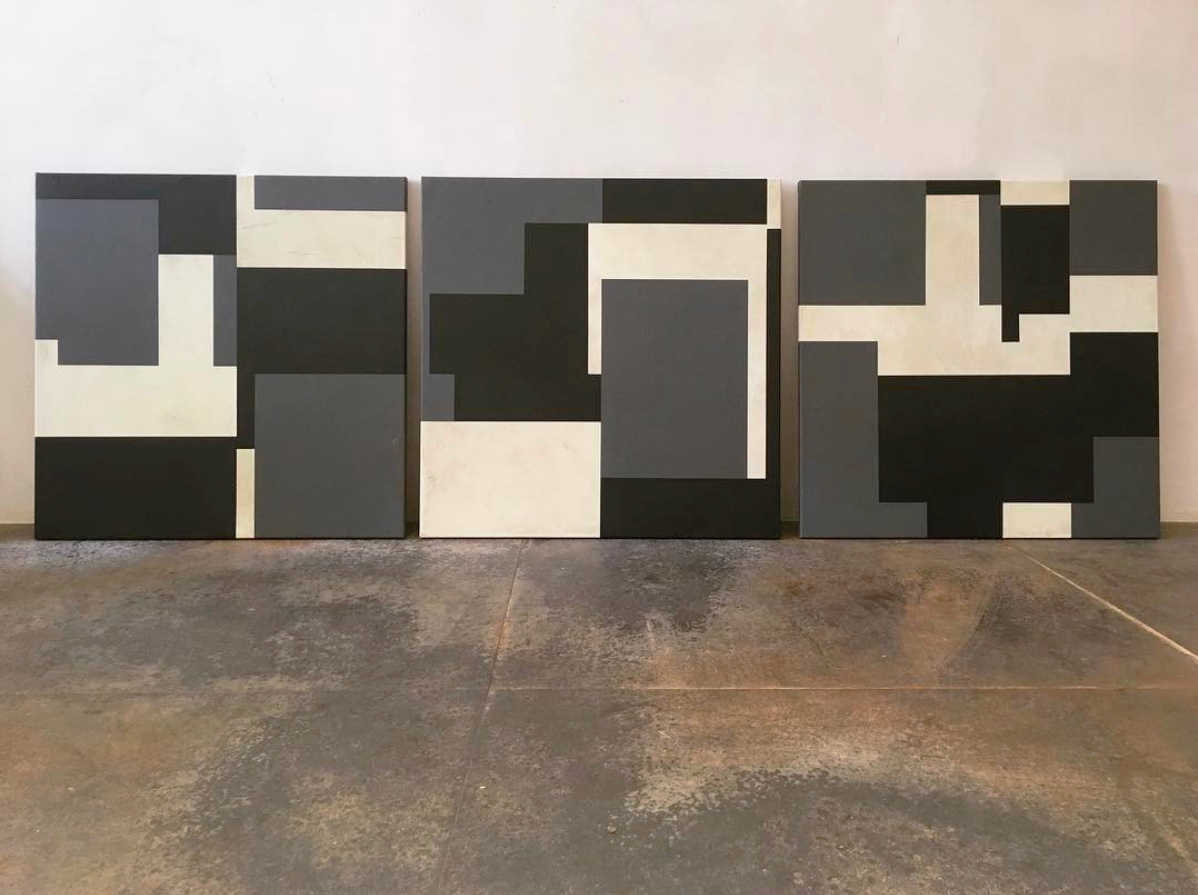Dusa jesih, Figure I. & Figure II. | Heroes, acrylic on canvas, 2x 100x150cm, 2017
Duša Jesih and New Geometry
Duša Jesih is one of the few Slovenian artists attentive to the fact that the legacy of constructed art is far from being depleted. This orientation, an optimistic, colourful and conceptually clear tendency, has never been gladly approved of within the context of the Slovenian sentiments of ‘pain and suffering’ – let us recall a veritable ‘pogrom’ sustained nearly a century ago by Avgust Černigoj at the hands of the local critics in Ljubljana –, while from an international perspective this orientation is one of the key parameters of modernist discourse. Constructivism, suprematism and the ensuing art movements have become a synonym for an alternative perception of art, its functions and relationship to reality. Op-art, kinetic art, new tendencies and the more recent neo-geo with Peter Halley as probably the most prominent contemporary artist are still a source of inspiration to younger artists who see an alternative to the present-day chaotic world at the intersection of rationality and sensuality or in that utopic concept of an artwork that was the aim of historical avant-gardes.
The recent paintings of Duša Jesih are prime examples of the new geometry, a subjective combination of formal exactness and distinctive expressivity of chromatic paint applications, with which the artist ‘challenges’ the strict rationalism in constructing a pictorial field. The alternation of colours – in the case of the featured work the interchange of red and black on a white background –, together with the juxtaposition of rectangular forms, invests the pictures with the requisite dynamism and tension, thus animating the painted surfaces and sensitising their perception. In spite of the widely established notion suggesting that painting of the geometrical type is inherently cold and insensitive, Jesih’s works stand as proof to the contrary: both form and colour contain an immanent emotional charge. In continual interaction, this charge is thematised and contextualised in a symbolic dialogue between explicit and implicit evocations that reflect interhuman relationships, their permutations and different intensities of their oscillations. In the painting process, the grid-like structure, whose basic elements are a square, a circle and a triangle, follows the artist’s concurrent psychological impulses, unpredictable impetuses that can generate, from the same basic components, invariably different pictorial solutions. Enhanced through colour into autonomous visual entities, these pictorial representations yield themselves to different interpretations, each viewer will perceive and embrace them differently, not necessarily in accordance with the original artistic intention and eventual realisation. Separating and linking colour surfaces within geometrical modules presents an aesthetic norm without preordained ‘natural’ models emulated or (re)interpreted by traditional painting, although geometric shapes are to be found in nature, indubitably the norm for those of Jesih’s works that are difficult to discern with the naked eye (crystals, microscopically small structures) or tend to be identified as the principle of more complex formations and phenomena. The aesthetics of geometrism that defines the oeuvre of Duša Jesih finds its theoretical basis in “Gestalt”, a concept according to which all forms, even the simplest ones, are carriers of a certain meaning and thus will never be neutral or self-sufficent, which is ultimately substantiated by the rich history of symbolic meanings of individual shapes, which various cultures and ideologies interpreted in different ways, occasionally even acquiring diametrically opposed connotations. Whatever applies to shapes also applies to colours, which either interact with the shapes or function independently as abstract notions. Visual language as an open system of signs thus constitutes an inexhaustible source of inspiration for nonverbal communication. Brane Kovič
Duša Jesih in nova geometrija
Duša Jesih je ena redkih slovenskih avtoric, ki se zaveda, da izročilo konstruirane umetnosti še zdaleč ni izčrpano. Ta v bistvu optimistična, barvita in konceptualno jasna usmeritev v kontekstu slovenskega bolečinarstva in trpečnosti ni bila nikoli dobrodošla – samo spomnimo se pravcatega »pogroma«, ki ga je bil od lokalnih kritiških korifej v Ljubljani pred slabim stoletjem deležen Avgust Černigoj -, medtem ko v mednarodnih okvirih sodi med ključne parametre modernističnega diskurza. Konstruktivizem, suprematizem in gibanja, ki so jima sledila, so postala sinonim drugačnega pojmovanja umetnosti, njenih funkcij in razmerja do realnosti. Op-art, kinetizem, nove tendence in nedavno neo-geo s Petrom Halleyem kot verjetno najbolj izpostavljenim sodobnikom so še vedno vir navdiha tudi mlajšim ustvarjalcem, ki vidijo alternativo kaotičnemu svetu na stičišču racionalnosti in čutnosti oziroma tistega utopičnega zastavka umetniškega dela, h kateremu so stremele zgodovinske avantgarde.
Slike Duše Jesih, ki nastajajo zadnja leta, so vzorčni primeri nove geometrije, subjektivne kombinacije formalne eksaktnosti in prepoznavne izraznosti kromatskih nanosov, s katerimi umetnica »spodnaša« strogi racionalizem zasnove slikovnega polja. Alternacija barv – v konkretnem primeru rdeče in črne na beli podlagi – hkrati z jukstapozicijo pravokotniških oblik zagotavlja njenim podobam potrebno dinamiko in napetost, ki poslikane površine oživljata in senzibilizirata njihovo percepcijo. V nasprotju s precej razširjenim prepričanjem, da je slikarstvo geometrijskega tipa že samo po sebi hladno in brezčutno, nam Jesihova s svojimi deli dokazuje nasprotno: tako forma kot barva imata lasten čustven naboj, njuna medsebojna razmerja pa ga nenehno tematizirata in kontekstualizirata v simbolnem dialogu eksplicitnih in implicitnih pomenjenj, ki reflektirajo medčloveške odnose, njihove permutacije in različne intenzitete njihovih oscilacij. Mrežna struktura, katere osnovni elementi so kvadrat, krog in trikotnik, se v procesu slikanja prilagaja avtoričinim vsakokratnim psihičnim impulzom, ki so nepredvidljivi in zato lahko iz istih temeljnih komponent generirajo vsakič drugačne podobotvorne rešitve, nadgrajene z barvo v avtonomne vizualne entitete, ki jih vsak gledalec dojema in sprejema drugače, ne nujno tako, kot so bile avtorsko najprej zamišljene in realizirane. Ločevanje in povezovanje barvnih površin znotraj geometrijskih modulov predstavlja estetsko normo brez vnaprejšnjih »naravnih« predlog, ki ih je tradicionalno slikarstvo posnemalo ali (re)interpretiralo, čeprav geometrijske like poznamo tudi v naravi, nesporno vsekakor v tistih njenih delih, ki jih s prostim očesom težje vidimo (kristali, mikroskopsko majhne strukture) ali pa jih identificiramo kot princip kompleksnejših tvorb in fenomenov. Estetika geometrizma, s katero se istoveti opus Duše Jesih, ima svojo teoretsko podstat v konceptu »Gestalta«, po katerem so vse, tudi najenostavnejše oblike, nosilci določenih pomenov in torej nikakor ne morejo biti nevtralne, samozadostne, kar ne nazadnje potrjuje bogata zgodovina simbolnih pomenov posameznih likov, ki so jih različne kulture in ideologije razlagale na različne načine, včasih tudi z diametralno nasprotnimi konotacijami. Kar velja za like, velja tudi za barve, ki so z njimi bodisi v interakciji, bodisi kot abstraktni pojmi funkcionirajo neodvisno. Likovna govorica kot odprt sistem znakov zato ostaja neizčrpen vir možnosti neverbalne komunikacije. | Brane Kovič, Likovni kritiki izbirajo, v sodelovanju s Slovenskim društvom likovnih kritikov, 2017
Dusa Jesih, Figure I. & Heroines & Doubles | Heroes, acrylic on canvas, 2017
Dusa Jesih, Heroines & Doubles | Heroes, acrylic on canvas, 2x 100x100cm, 2017
Dusa Jesih, Ménage | Heroes, diptych 180x360cm, 2013-16
Dusa Jesih, Dusa Jesih, Coupling 01&02 | Heroes, 2x 100x150cm, acrylic on canvas, 2017
Dusa Jesih, We can do it, acrylic on canvas, 3x 100x180cm, 2017
Dusa Jesih, Yes we can, acrylic on canvas, 180x180cm, 2017
Dusa Jesih, Match, acrylic on canvas, triptych 3x 60x60cm, 2017
